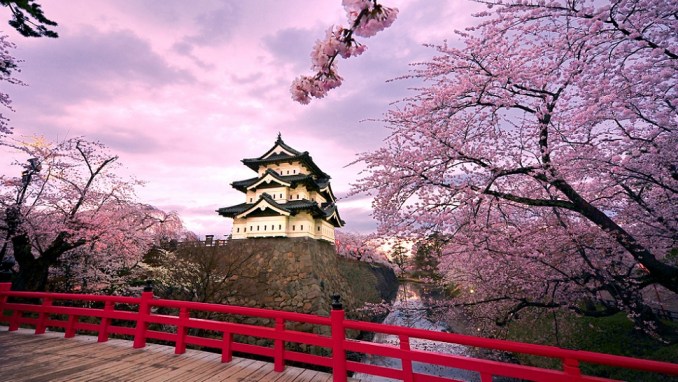Japan’s colorful shrines, fascinating geisha districts and age-old Buddhist temples stand witness to the country’s rich cultural heritage and ancient history. From the famous monuments in the stunning imperial city of Kyoto to the bustling capital of Tokyo with its dizzying dimensions and flashing neon lights, there is no shortage of major attractions to visit and explore in the land of the rising sun. But remarkably, Japan is not very popular with tourists, because of language troubles (most Japanese people don’t speak English very well) and the expensive lifestyle (transport, food, and accommodations). And that’s a shame, because Japan is a fascinating country that should be on your bucket list, since it represents a unique and inspiring blend of traditional and ultramodern cultures.
Get the most out of your (luxury) trip to Japan with my travel guide. Find out more about:
- Best time to visit
- How to get there
- Travel requirements
- Getting around
- Inspiration, highlights, & travel tips
- Suggested itineraries
- Recommended luxury hotels (+ reviews)
BEST TIME TO VISIT
The best time to visit Japan is spring (March to May) or autumn (September to November). Spring is marked by mild temperatures and dry days, and this is also the season when a lot of the country is ablaze with magnificent white and pink cherry blossom. The blossoms themselves last only a few days, symbolizing to Japanese the fragile nature of beauty and of life itself, and are celebrated throughout the country with numerous festivals. Autumn enjoys similar, delightful temperatures as in spring, with the Japanese landscape changing into a haven of red and scarlet leaves which contrast strikingly against the deep blue clear skies.
Summer (June to August) isn’t the best time to visit Japan, since it coincides with the rainy season and the weather feels hot, uncomfortable, and muggy. The rains, which peak in July, aren’t seen every day like in some monsoonal Asian countries, although it does rain a lot, sometimes quite heavily, making umbrellas imperative. The period from the end of August to September is typhoon season, although the majority of storms stays out on the Pacific Ocean and rarely makes landfall.
Winter (December to March) sees generally dry weather, with mostly blue skies on the coastal areas. It’s a wonderful time to visit Japan, if you don’t mind the often crispy cold temperatures, which drives flocks of locals to the traditional Japanese onsen (hot springs). Northern Japan – which includes Hokkaido island – is often covered by a snow carpet (and very popular for skiing) although weather is milder towards the south, with major cities like Tokyo, Kyoto and Osaka only receiving minimal snowfall during the winter months.
The worst time to visit Japan is probably Gold Week, which is a collection of four national holidays within a time frame of seven days (April 29 to May 5), since it’s Japan’s busiest holiday season, with high rates and low availability for hotels and public transport.
For a month to month weather report in Japan, check this website.
HOW TO GET THERE
Japan receives numerous international daily flights via its four main international airports: Narita and Haneda Airports (near Tokyo); Kansai International Airport (near Osaka and Kyoto); and New Chitose Airport (near Sapporo). There are also many regional airports with short-haul international flights to countries in Asia, such as China, Korea, Hong Kong and Taiwan.
- Narita International Airport (NRT) is the predominant international airport serving the Greater Tokyo Area, located approximately 60 km (37 mi) east of central Tokyo. Click here for a list of airlines that offer direct flights to Narita International Airport.
- Haneda Airport (HND) is located closer to Tokyo’s city center as compared to Narita and is the primary base of Japan’s two major domestic airlines, Japan Airlines (Terminal 1) and All Nippon Airways (Terminal 2). It’s Tokyo’s main domestic airport, although it offers an increasing range of international destinations as well. Click here for a list of airlines that offer direct flights to Haneda.
- Kansai International Airport (KIX) is located on an artificial island in the middle of Osaka Bay, and serves the Osaka and Kyoto metropolitan areas. Click here for a list of airlines that offer direct flights to Kansai International Airport.
- New Chitose Airport (CTS) is an airport located on Japan’s Hokkaidō island, serving the Sapporo metropolitan area. The 894 km (556 mi) New Chitose – Tokyo Haneda route is the busiest air route in the world. Click here for a list of airlines that offer direct flights to New Chitose Airport.
Before you buy a plane ticket, consider reading my tips & tricks for buying the cheapest plane ticket.
TRAVEL REQUIREMENTS
Requirements for entry into Japan differ from country to country, and are subject to change. Prior to departure, always check with your government and your nearest Japanese embassy or consulate what documents you need for travel to Japan.
- You need a passport with at least six months validity to enter Japan.
- Visa exemptions are made for citizens of more than 60 countries provided that their stays don’t last longer than 90 days and that they do not engage in activities where they earn compensation. Nationals of countries that do not have “Reciprocal Visa Exemption Arrangements” with Japan must obtain a visa.
Make sure you read my 10 tips to plan a worry-free trip.
GETTING AROUND
Japan has an efficient public transportation network, especially within metropolitan areas and between the large cities. Japanese public transportation is characterized by its punctuality, its superb service, and the large crowds of people using it. The different means of transport within Japan are well explained on this very helpful website, which I highly recommend when you plan a holiday to Japan.
- Most travelers will make use of Japan’s excellent train network. Japan’s four major islands, Honshu, Hokkaido, Kyushu, and Shikoku, are covered by an extensive and reliable network of railways. Trains are a very convenient, safe and clean way for visitors to travel, especially in conjunction with the Japan Rail Pass (cf below). About 70 percent of Japan’s railway network is owned and operated by Japan Railways, while the remaining 30 percent belongs to dozens of other private railway companies, especially in and around metropolitan areas.
- Japan’s main islands of Honshu, Kyushu and Hokkaido are served by a network of high-speed train (bullet trains) lines that connect Tokyo with most of the country’s major cities. Japan’s high-speed trains are called shinkansen and are operated by Japan Railways. Running at speeds of up to 320 km/h (200 mi/h), the shinkansen is known for punctuality (most trains depart on time to the second), comfort (relatively silent cars with spacious, always forward facing seats), safety (no fatal accidents in its history) and efficiency.
- Thanks to the Japan Rail Pass, the transport via train and shinkansen can also be a very cost-effective means of travel. It can be used by foreign tourists only, and offers unlimited use of Japan Railways trains for one, two or three weeks at a favorable rate. If you plan to make just one long-distance train journey, such as Tokyo to Kyoto one way, a Japan Rail Pass will not be good value. In all other cases it will be and you should invest in one before you arrive, since the full Japan Rail Pass can only be bought outside Japan (other types of passes can bought inside the country though). Read more about the Japan Rail Pass here.
- Domestic flights are also well worth considering, although the superlative train network makes the plane a secondary mode of transport within Japan. Japan’s major cities are connected daily via multiple flights and the cost of a domestic tickets can be quite reasonable. Both JAL and ANA offer discount flight passes to overseas visitors, which are definitely worth considering if you plan to make several domestic plane trips. Tickets can be booked online on the website of the many carriers that offer flights within Japan, with Japan Airlines and All Nippon Airways dominating the market:
- Japan Airlines (this is Japan’s national carrier, a Oneworld Alliance member)
- All Nippon Airways (a Star Allliance member)
- Other airlines (mostly regional and/or low cost carriers): StarFlyer, Solaseed Air, SkyMark Airlines, Fuji Dream Airlines, and Air Do.
INSPIRATION, HIGHLIGHTS, & TRAVEL TIPS
There are several good reasons why you should put Japan on your bucket list:
- The iconic vista of Mount Fiji
- The ancient imperial cities of Kyoto and Nara
- Staying at an authentic ryokan
- Hiroshima’s memorial park
- The Miyajima shrine
- The wilderness of Hokkaidō island
- Getting ‘lost in translation’ in Tokyo
- Staying at some of Asia’s best luxury resorts
The following, in-depth articles may also inspire you and help you plan your holiday to Japan:
- Top 10 best things to see & do in Japan
- Top 10 most fabulous luxury resorts in Japan
- Top 10 best luxury hotels in Tokyo
- Tips & tricks for getting the best deal at a luxury hotel
- Tips & tricks for buying the cheapest plane ticket
SUGGESTED ITINERARIES
It’s impossible to suggest one itinerary for Japan, but I hereby share with you a two-week schedule based on my own travel experiences in Japan. Three weeks are recommended though if you have more time and want to travel at a more leisurely pace).
- Day 1-3: explore Tokyo (recommended hotels: Andaz Tokyo, Park Hyatt Tokyo, Aman Tokyo).
- Day 4-5: explore Hakone & Mount Fiji (recommended hotel: Hyatt Regency Hakone).
- Day 6-7: explore Hiroshima & day trip to Miyajima island (recommended hotel: Sheraton Hiroshima).
- Day 8-9: explore Osaka & day trip to Nara (recommended hotel: St Regis Osaka).
- Day 10-12: relax at Ise-Shima National Park (recommended hotel: Amanemu).
- Day 13-15: explore Kyoto (recommended hotels: Four Seasons Kyoto, The Ritz-Carlton Kyoto).
For the planning of your own travel itinerary in Japan, I highly recommend the website Japan Guide, which boasts plenty of helpful information. In addition, for more ideas, I suggest the excellent Japan itineraries as provided by The Rough Guides and Frommers.
RECOMMENDED LUXURY HOTELS (+ REVIEWS)
Consider visiting my top 10 lists if you are eager to know how I rank Japan’s top hotels, based on my own experience:
Below, you find my reviews of hotels in Japan (with pros, cons, and tips to save money per hotel).
 Hotel review: The Ritz-Carlton Kyoto (Japan)
Hotel review: The Ritz-Carlton Kyoto (Japan) Hotel review: Andaz Tokyo Toranomon Hills (Japan)
Hotel review: Andaz Tokyo Toranomon Hills (Japan) Hotel review: The St Regis Osaka (Japan)
Hotel review: The St Regis Osaka (Japan) Review: “Lost in Translation” at the Park Hyatt Tokyo (Japan)
Review: “Lost in Translation” at the Park Hyatt Tokyo (Japan) Review: Hyatt Regency Hakone Resort & Spa (Japan)
Review: Hyatt Regency Hakone Resort & Spa (Japan) Hotel review: phenomenal Aman Tokyo (Japan)
Hotel review: phenomenal Aman Tokyo (Japan) Hotel review: Amanemu, Shima Peninsula (Japan)
Hotel review: Amanemu, Shima Peninsula (Japan)
*** Follow me on Twitter, Instagram and Facebook for a daily moment of travel inspiration ***



Be the first to comment